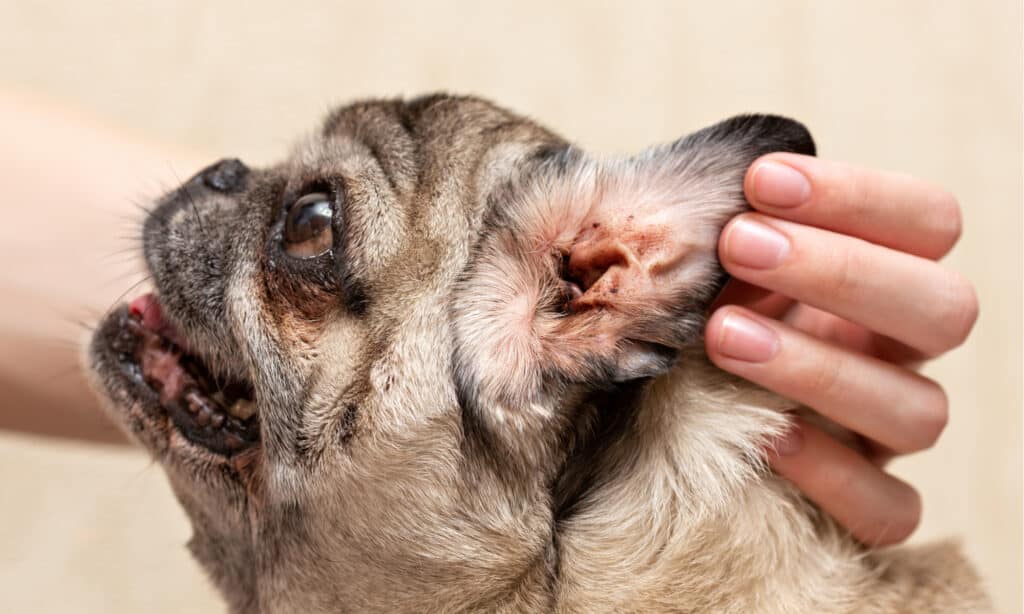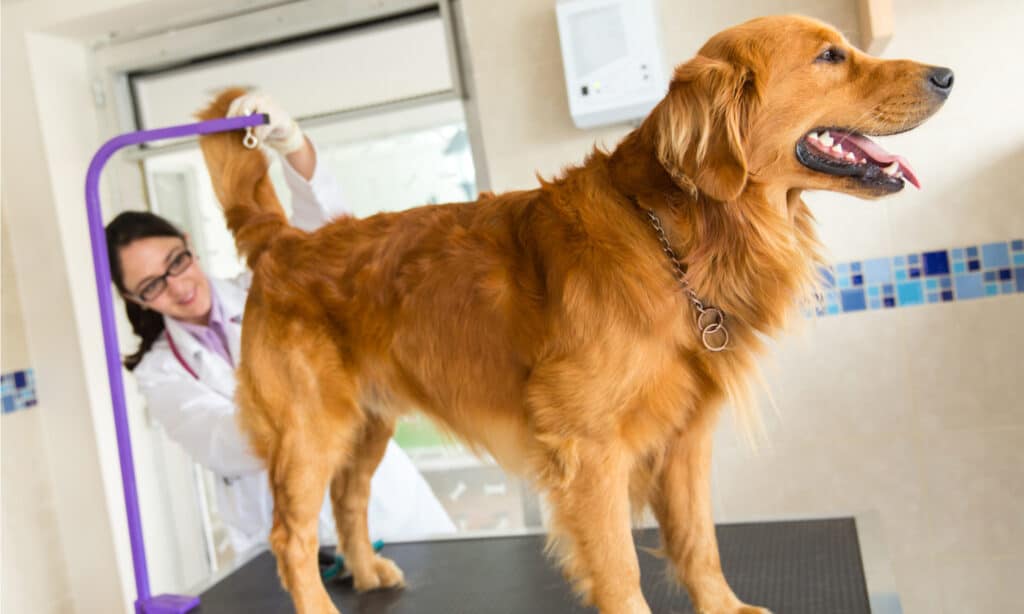This is probably one of the most mortifying things that your dog can do when you have guests over for dinner. So, why do dogs drag their butts? Surely, they are not doing it just to make us feel embarrassed?
Butt dragging also called scooting, is simply a dog’s way of trying to ease some irritation in their anal area. All you have to do is figure out what is causing that irritation. Here, we have compiled an exhaustive list of all the things that could be causing the discomfort. Plus, top hacks and advice on how to prevent the issue from happening again.
Is It Normal For Dogs To Butt Drag?
If this just happens every now and again then it is unlikely to be anything to worry about. For dogs, this is a natural way to try and relieve irritation. However, if your dog is doing it a lot, it indicates that the irritation is on-going, and you need to investigate what is causing it.
Never tell your dog off or punish your dog for scooting. They are not being ‘naughty’ and it is not a habit. Dogs only do this when they are in genuine discomfort.
Why Do Dogs Drag Their Butts?
Dogs drag their butts because the area around their butt (anus) is irritated or uncomfortable. Here are the leading potential causes:
Anal sac problems
The most common cause of scooting in dogs is an issue with their anal glands/sacs. These are two small sac-like structures that are found on the side of your dog’s anus (butt). When your dog poops, the anal sacs release a liquid that humans find completely disgusting – it smells like rotting fish. To dogs, however, it is a useful biomarker. It signals to other dogs that your dog is in the area.
Sadly, things can go wrong with anal sacs! They can get blocked and inflamed. They can even get infected, and an abscess can form. Anal sacs can also rupture if they are squeezed too often or people who do not know what they are doing. This is a job best left to the professionals.
If the butt dragging is down to blocked anal sacs, you may notice some other symptoms as well. Your pooch may have trouble having a poop or they may obsessively lick their butt and groin. You may also notice a very unpleasant fish-like odor coming from their rear end!
Irritation caused by poop
Most dogs are very neat when they have a poop, and no fecal matter is left around their butt. Dogs with diarrhea, on the other hand, can get a bit messy!
The poop can cling to their coat in this area, and it can cause irritation.
Parasites
Worms and fleas can cause butt irritation. Flea bites themselves can cause irritation in this area but they are also involved in the flea cycle of tapeworm. The tapeworm gets into your dog’s body when they ingest an infested flea. Then, the tapeworm causes additional irritation around your dog’s butt. You may be able to spot the tiny segments of a tapeworm (they look like white grains of rice) on your dog’s coat.
Skin irritation
Lots of things can cause skin irritation around the anal area but grooming products are common culprits. There could be a burn from clippers or a sore spot caused by sprays or shampoos.

©Glikiri/Shutterstock.com
Food allergies
Food allergies and sensitivities can cause repeated soft and watery poops that do not exert enough pressure to naturally empty the anal sacs. Food allergies are usually connected with a type of protein (such as chicken) but may be caused by wheat, corn or soy, or many other ingredients in commercial dog food or in homemade foods.
Constipation and rectal prolapse
Dogs that are constipated may scoot to relieve the discomfort. Repeated straining can lead to a rectal prolapse where part of the intestines come out of your dog’s bottom. This is a medical emergency.
Why Do Dogs Drag Their Butts When Excited?
Sudden excitement (and fear) in dogs can cause them to empty their anal sacs. This is a reflex reaction and is not something that they can control. Then, they drag their butts to remove the foul-smelling fluid from their coat. This is not great if they are transferring it to your carpet!
Why Do Dogs Drag Their Butts After Pooping?
This may be because your dog is constipated and needs another poop. Alternatively, they may have some poop on their coat that they are trying to rub off. Another possibility is that their anal sacs are irritating them because they were not emptied when they had a poop.
Why Do Female Dogs Scoot?
In female dogs, scooting could be a sign of a urinary tract infection (sometimes called a water infection) or a vaginal infection. However, it is far more likely to be one of the causes that we listed above and that can occur in both male and female dogs.
Which Dog Breeds Scoot The Most?
Anal gland problems affect 4% of dogs and are more common in older dogs. Some breeds are more often affected than others. King Charles Spaniels, Shih Tzus, Bichon Frises, and Cocker Spaniels are most often affected. So are all of the brachycephalic breeds. Boxers are the least likely to have this problem but that does not mean that it can never happen!
How Do I Stop My Dog From Scooting?
This depends on what is causing the problem. Anal gland issues can be rectified in a number of ways. You can try to express the glands yourself at home, but you need to be careful because you could cause damage to the delicate structures inside the body. It may be wiser to get a veterinary nurse to do it. You could also try applying a warm compress.
If this is not successful, your vet may need to prescribe antibiotics or anti-inflammatories, or they may need to carry out surgery to flush the anal sacs.
Any substance that could be causing the irritation should be gently wiped away with a moist, soft cloth. If you find evidence of infestation by fleas or worms, these need to be treated with the appropriate medication.
Skin irritation from grooming products can be cured by swapping to a hypoallergenic natural brand that will not irritate the skin.
Constipation, diarrhea and rectal prolapse need to be treated by a vet.

.
©ESB Professional/Shutterstock.com
What If My Dog Is Still Scooting After Expressing Anal Glands?
Don’t panic. It can take a few days for the discomfort to die down and the scooting to stop. It is highly unlikely that the glands have filled back up again, and they will not need to be manually emptied again.
If your dog is still scooting three days after having its anal glands expressed, there is probably another cause for the irritation. Pop back to see your vet about this.
How To Prevent Butt Dragging In Dogs
The obvious question after ‘why do dogs drag their butts’ is ‘how do you stop it’? We would always advise that you check in with your vet first to see if your dog needs some treatment. Your vet will also be able to advise if your dog needs a change of diet and they can support you as you introduce this change. At the same time, let’s consider some things that you can do at home to help prevent this problem.
Feed your dog a balanced diet
Feed your dog a high-quality and balanced diet. This is a highly effective way of preventing anal gland problems for several reasons. It ensures that the consistency of your dog’s poop is just right to prevent the anal glands from getting blocked. It also ensures that your dog does not get too many calories which can make them obese.
Watch their weight
Obese dogs are more likely to have anal gland problems. If your dog is pilling on the pounds, transition them to a weight-management dog food. This can be a particular problem as dogs get older and are not so active.
Consider adding fiber
Adding fiber to your dog’s diet may help to firm up their poops and this can help to naturally empty the anal glands. There are many high-fiber dog foods that you could choose from. You can add your own flaxseed, sweet potatoes, or squash to your dog’s diet, but it is often safer to purchase a commercial fiber supplement.
Probiotics may help
Some owners have found that giving their pooch a diet that contains probiotics can help with gut health and anal gland issues. Many high-quality commercial dog foods contain probiotics.
Always provide fresh water
A lack of hydration in dogs can lead to constipation and this may irritate the anal area. Not all dogs like to drink a lot so you may need to encourage them, especially if they are on a dry food diet. Some dogs do not like plastic water bowls so it may be best to invest in stainless steel or ceramic water bowl. Another option that many dogs love is a water fountain.
Investigate if your dog has allergies
Many dogs have sensitivities and allergies to certain foods. This can make their poops soft and watery and the anal glands do not get emptied as they should. Some owners find that adding pumpkin to their dog’s food can help. Others choose a special food for dogs with allergies. Always talk to your vet about this first.
Prevent parasites
Give your dog regular treatment for all parasites including intestinal worms. Tapeworms are passed to dogs by fleas, so it is also important that you use an effective flea treatment at the same time. Flea bites can also be a source of irritation.
Take care with grooming products
Take care in your choice of grooming products. Choose natural shampoos that work in harmony with your dog’s body and will not cause irritation to sensitive areas such as the genitals and anus.
Exercise and general health
Dogs that get the correct level of exercise and are healthy are less likely to get anal irritation. Taking your pooch on regular walks stimulates their digestive system and helps their poops to form at the right consistency.
Regular walks also give your dog plenty of opportunities for them to have a poop. When they poop, they naturally empty their anal sacks and that can prevent blockages. Don’t forget to take poo sacks with you!
The photo featured at the top of this post is © SasaStock/Shutterstock.com
Ready to discover the top 10 cutest dog breeds in the entire world?
How about the fastest dogs, the largest dogs and those that are -- quite frankly -- just the kindest dogs on the planet? Each day, AZ Animals sends out lists just like this to our thousands of email subscribers. And the best part? It's FREE. Join today by entering your email below.
Thank you for reading! Have some feedback for us? Contact the AZ Animals editorial team.






